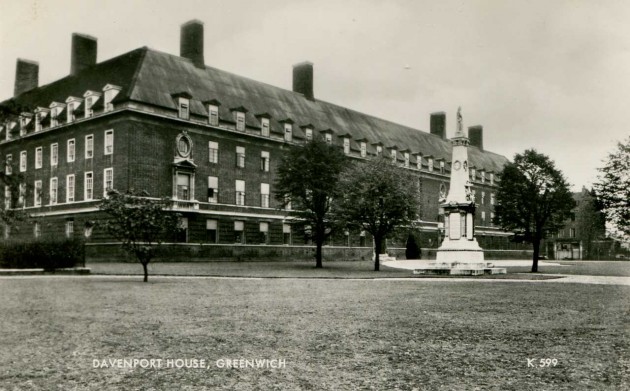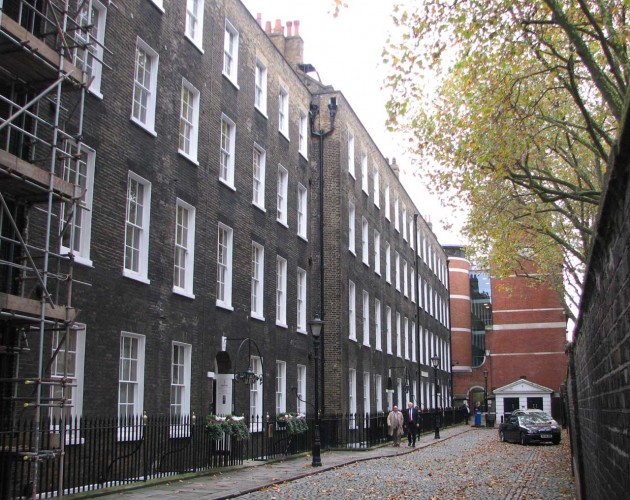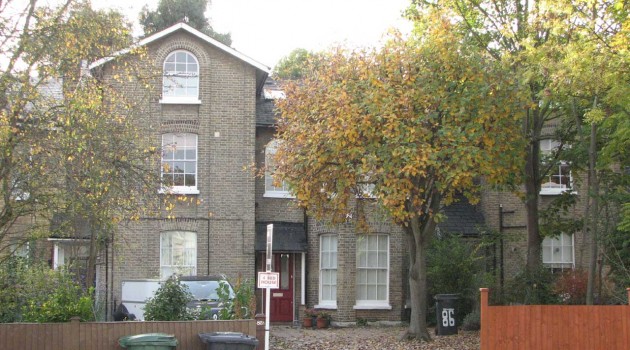…where east meets west
- Home
- Brief History
- The Greenwich Meridian
- Greenwich
(1675–1958) - Herstmonceux
(1948–1990) - Cambridge
(1990–1998) - Outstations (1822–1971)…
- – Chingford (1822–1924)
- – Deal
(1864–1927) - – Abinger
(1923–1957) - – Bristol & Bradford on Avon
(1939–1948) - – Bath
(1939–1949) - – Hartland
(1955–1967) - – Cape of Good Hope
(1959–1971)
- Administration…
- – Funding
- – Governance
- – Inventories
- – Pay
- – Regulations
- – Royal Warrants
- Contemporary Accounts
- People
- Publications
- Science
- Technology
- Telescopes
- Chronometers
- Clocks & Time
- Board of Longitude
- Libraries & Archives
- Visit
- Search
Premises of (HM) Nautical Almanac Office since its creation in late 1831 or early 1832
Overseeing the production of the Almanac was originally the responsibility of the Astronomer Royal. In 1818, while John Pond was Astronomer Royal, this responsibility passed to Thomas Young, holder of the new post of Superintendent, who reported to the Board of Longitude. In 1829 Pond resumed responsibility for the Almanac, retaining it until 1831, when the post of Superintendent passed to William Stratford. It was Stratford, who in late 1831 or early 1832, set up the Nautical Almanac Office (NAO) to oversee the Almanac’s production, with the Superintendent now reporting to the Admiralty.
At the start of the reign of King Edward VII (between November 1902 and January 1904), the name of the Office was changed to His Majesty’s Nautical Almanac Office (HMNAO). In 1937, HMNAO became part of the Royal Observatory. When the Observatory was closed down in 1998, it was transferred to the Rutherford Appleton Laboratory. In December 2006, it was transferred again, this time to the United Kingdom Hydrographic Office.
Dates |
Address |
Notes |
|
| 1832 | 3 Verulam Buildings, Gray’s Inn, London, WC1 | ||
| 1832–1841 | Somerset House, Strand, London, WC2 | 1 | |
| 1842–1917 | 3 Verulam Buildings, Gray’s Inn, London, WC1 |
2 | |
| 1917–1922 | 86 Lee Road, London, SE3 |
2, 3 | |
| 1922–1939 | Royal Naval College, Greenwich, London, SE10 | 4 | |
| 1939–1939 | Devonport House, King William Walk, Greenwich, London, SE10 | 5 | |
| 1939–1941 | Laggan, College Road, Bath | 6 |
|
| 1941–1949 | Block E, Ensleigh Hutments, Lansdowne Hill, Bath |
7 | |
| 1949–1990 | Royal Greenwich Observatory, Herstmonceux | ||
| 1990–1998 | Royal Greenwich Observatory, Cambridge | ||
| 1998–2006 | Rutherford Appleton Laboratory | ||
| 2006– | United Kingdom Hydrographic Office, Taunton |
Notes
| 1 | Somerset House was home to the Navy Board. | |
| 2 | The move from Gray’s Inn took place on 26 September. At that time, the Superintendent was Philip Cowell, a former Chief Assistant at the Royal Observatory, who lived in Blackheath just a mile and a half away from the new premises. Built as a private house, 86 Lee Road had previously been occupied by the Verheydens who were both dental surgeons. The house is back in residential use, but is now divided. |
|
| 3 | The move from Lee Road took place on 30 August. Cowell was still Superintendent. |
|
| 4 | Formerly known as Greenwich Hospital, now the Old Royal Naval College (ORNC). In his Personal History of HM Nautical Almanac Office, Donald Sadler describes the accomodation when he arrived in 1930. It was on the first floor of the King Charles Building (the most westerly of the two blocks adjacent to the river). It consisted of: one long narrow room used by the Superintendent and, when necessary, by his shorthand-typist; a large light room, communicating with the Superintendent’s room, often occupied by 6 or 7 staff and a largish, square, dark room on the opposite side of the stairway. In addition there were two large store rooms on the mezzanine floor and a small machine room, which housed the Burroughs Class II two-register printing/adding machine. Heating in the main rooms was by open fires attended to by the messenger. There were toilet facilities for men, but the women had to use those in another building. Another room with a small window was allocated soon after Sadler’s arrival followed by a number of rooms on the second floor. |
|
| 5 | Devonport House was a nurse’s home attached to the Seamen’s Hospital. Largely built between 1925 & 1934 as an extension to the pre-existing eighteenth and nineteenth century infirmary of the Royal Hospital School, it is now in joint use as student accommodation and as a hotel and conference centre. The move from the Naval College was necessary, partly because the College needed the space back and partly because HMNAO required more space rather than less. As things turned out, HMNAO was only in Devonport House for a few weeks during August and September. |
|
| 6 | With the outbreak of war, the Office was evacuated from London towards the end of September. Laggan was a private house requisitioned by the Admiralty; it is now known as Laggan House and is divided into flats. | |
| 7 | The Ensleigh Hutments were one of three sets of wartime hutments constructed for the Admiralty in Bath. The Ensleigh Hutments consisted of five blocks (A–E). |

The King Charles Building of the Royal Naval College, home of HM Nautical Almanac Office from 1922–1939. From an anonymously published postcard posted in 1914

The north front of Devonport House c.1950. Damaged during the war, the building is seen here with a temporary corrugated iron roof and pock marks in the brickwork. From a postcard (K599) published by Valentine's
© 2014 – 2025 Graham Dolan
Except where indicated, all text and images are the copyright of Graham Dolan




